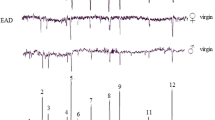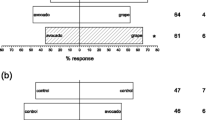Abstract
The tortricid moths Lobesia botrana (Denis and Schiffermueller) and Eupoecilia ambiguella (Hübner) are major insect pests of grapevine Vitis vinifera. We compared the pattern of volatile organic compounds in headspace samples of four different grapevine cultivars in dependency of their phenological stage by thermodesorption coupled with gas chromatography (GC) and mass spectrometry. Further, we assessed the detection of compounds by the antenna of both moth species by GC coupled with electroantennographical detection. We detected significant differences between the chemical compositions of headspace samples of the four cultivars based on the odor bouquet. By comparing the principal component linear discriminant analysis pattern of only those chemical compounds that could be actually detected by the moths’ antenna, the different cultivars showed similar odor patterns indicating that differences measured by GC may not be detected by the moths’ antenna. The supposed reduced discriminatory ability of both moth species was supported by behavioral bioassays using a Y-tube olfactometer. In connection to the recently published impact of the berries’ visual appearance (shape and color) and nonvolatile compounds of the wax layer, the presented results suggest that reported moth preferences for specific cultivars are not encoded by volatiles only. The results of this study will contribute to the development of an innovative egg-monitoring tool for grapevine moths.






Similar content being viewed by others
References
Anfora G, Tasin M, Bäckman AC, Leonardelli E, De Cristofaro A, Lucchi A, Ioriatti C (2008) Olfactory responses of Eupoecilia ambiguella (Hübner) (Lepidoptera tortricidae) females to volatiles from grapevine. IOBC/wprs Bull 36:233–236
Anfora G, Tasin M, De Cristofaro A, Ioriatti C, Lucchi A (2009) Synthetic grape volatiles attract mated Lobesia botrana females in laboratory and field bioassays. J Chem Ecol 35:1054–1062. https://doi.org/10.1007/s10886-009-9686-5
Birgücü AK, Turanlı F, Gümüş E, Güzel B, Karsavuran Y (2015) The effect of grape cultivars on oviposition preference and larval survival of Lobesia botrana Den. & Schiff. (Lepidoptera: Tortricidae). Fresen Environ Bull 24:33–38
Conchou L, Anderson P, Birgersson G (2017) Host plant species differentiation in a polyphagous moth: olfaction is enough. J Chem Ecol 43:794–805. https://doi.org/10.1007/s10886-017-0876-2
Dudareva N, Negre F, Nagegowda DA, Orlova I (2006) Plant volatiles: recent advances and future perspectives. Crit Rev Plant Sci 25:417–440. https://doi.org/10.1080/07352680600899973
Fall R, Karl T, Hansel A, Jordan A, Lindinger W (1999) Volatile organic compounds emitted after leaf wounding: on-line analysis by proton-transfer-reaction mass spectrometry. J Geophys Res-Atmos 104:15963–15974. https://doi.org/10.1029/1999JD900144
Fermaud M (1998) Cultivar susceptibility of grape berry clusters to larvae of Lobesia botrana (Lepidoptera: Tortricidae). J Econ Entomol 91:974–980. https://doi.org/10.1093/jee/91.4.974
Fermaud M, Giboulot A (1992) Influence of Lobesia botrana larvae on field severity of Botrytis rot of grape berries. Plant Dis 76:404–409. https://doi.org/10.1094/PD-76-0404
Gross J, Gündermann G (2016) Principles of IPM in cultivated crops and implementation of innovative strategies for sustainable plant protection. In: Horowitz A, Ishaaya I (eds) Advances in insect control and resistance management. Springer, Basel, pp 9–26
Gross J, Gallinger J, Rid M (2019) Collection, identification and statistical analysis of volatile organic compound patterns emitted by phytoplasma infected plants. In: Musetti R, Pagliari L (eds) Phytoplasmas: methods and protocols, methods in molecular biology, vol 1875. Springer, New York, pp 333–343. https://doi.org/10.1007/978-1-4939-8837-2_25
Knolhoff LM, Heckel DG (2014) Behavioral assays for studies of host plant choice and adaptation in herbivorous insects. Annu Rev Entomol 59:263–278. https://doi.org/10.1146/annurev-ento-011613-161945
Lima A, Pereira JA, Baraldi I, Malheiro R (2017) Cooking impact in color, pigments and volatile composition of grapevine leaves (Vitis vinifera L. var. Malvasia Fina and Touriga Franca). Food Chem 221:1197–1205. https://doi.org/10.1016/j.foodchem.2016.11.039
Lorenz DH, Eichhorn KW, Blei-Holder H, Klose R, Meier U, Weber E (1994) Phänologische Entwicklungsstadien der Weinrebe (Vitis vinifera L. ssp.). Vitic Enol Sci 49:66–70
Maher N, Thiéry D (2004) Distribution of chemo- and mechanoreceptors on the tarsi and ovipositor of female European grapevine moth, Lobesia botrana. Entomol Exp Appl 110:135–143. https://doi.org/10.1111/j.0013-8703.2004.00131.x
Maher N, Thiéry D (2006) Daphne gnidium, a possible native host plant of the European grapevine moth Lobesia botrana, stimulates its oviposition. Is a host shift relevant? Chemoecology 16:135–144. https://doi.org/10.1007/s00049-006-0339-7
Maher N, Jolivet M, Thiéry D (2001) Oviposition preference of the European grape vine moth, Lobesia botrana (Lepidoptera: Tortricidae) for different vine cultivars: influence of chemical stimuli from the fruit surface. IOBC/wprs Bull 24:103–108
Maher N, Thiéry D, Stadler E (2006) Oviposition by Lobesia botrana is stimulated by sugars detected by contact chemoreceptors. Physiol Entomol 31:14–22. https://doi.org/10.1111/j.1365-3032.2005.00476.x
Markheiser A, Rid M, Biancu S, Gross J, Hoffmann C (2018) Physical factors influencing the oviposition behaviour of European grapevine moths Lobesia botrana and Eupoecilia ambiguella. J Appl Entomol 142:201–210. https://doi.org/10.1111/jen.12423
Masante-Roca I, Anton S, Delbac L, Dufour MC, Gadenne C (2006) Attraction of the grapevine moth to host and non-host plant parts in the wind tunnel: effects of plant phenology, sex, and mating status. Entomol Exp Appl 122:239–245. https://doi.org/10.1111/j.1570-7458.2006.00510.x
Moreau J, Benrey B, Thiéry D (2006) Grape variety affects larval performance and also female reproductive performance of the European grapevine moth Lobesia botrana (Lepidoptera: Tortricidae). Bull Entomol Res 96:205–212. https://doi.org/10.1079/ber2005417
Pavan F, Stefanelli G, Villani A, Cargnus E (2018) Influence of grapevine cultivar on the second generations of Lobesia botrana and Eupoecilia ambiguella. Insects 9:11. https://doi.org/10.3390/insects9010008
Pers JN (1981) Comparison of electroantennogram response spectra to plant volatiles in seven species of Yponomeuta and in the tortricid Adoxophyes orana. Entomol Exp Appl 30:181–192. https://doi.org/10.1111/j.1570-7458.1981.tb03094.x
Pickett JA, Khan ZR (2016) Plant volatile-mediated signalling and its application in agriculture: successes and challenges. New Phytol 212:856–870. https://doi.org/10.1111/nph.14274
Ramachandran R, Khan ZR, Caballero P, Juliano BO (1990) Olfactory sensitivity of two sympatric species of rice leaf folders (Lepidoptera: Pyralidae) to plant volatiles. J Chem Ecol 16:2647–2666. https://doi.org/10.1007/bf00988076
Renwick J, Chew F (1994) Oviposition behavior in Lepidoptera. Annu Rev Entomol 39:377–400. https://doi.org/10.1146/annurev.en.39.010194.002113
Rid M, Mesca C, Ayasse M, Gross J (2016) Apple proliferation phytoplasma influences the pattern of plant volatiles emitted depending on pathogen virulence. Front Ecol Evol 3:152. https://doi.org/10.3389/fevo.2015.00152
Rid M, Markheiser A, Hoffmann C, Gross J (2018) Waxy bloom on grape berry surface is one important factor for oviposition of European grapevine moths. J Pest Sci 91:1225–1239. https://doi.org/10.1007/s10340-018-0988-7
R Core Team (2016) R: a language and environment for statistical computing. R Foundation for Statistical Computing. Vienna, Austria. https://www.R-project.org. Accessed 14 Aug 2017
Schmidt-Büsser D, von Arx M, Connetable S, Guerin PM (2011) Identification of host-plant chemical stimuli for the European grape berry moth Eupoecilia ambiguella. Physiol Entomol 36:101–110. https://doi.org/10.1111/j.1365-3032.2010.00766.x
Schoonhoven LM, van Loon JJA, Dicke M (2005) Insect-plant biology, 2nd edn. Oxford University Press, New York
Schreier P, Drawert F, Junker A (1976) Identification of volatile constituents from grapes. J Agric Food Chem 24:331–336. https://doi.org/10.1021/jf60204a032
Sharon R, Zahavi T, Soroker V, Harari AR (2009) The effect of grape vine cultivars on Lobesia botrana (Lepidoptera: Tortricidae) population levels. J Pest Sci 82:187–193. https://doi.org/10.1007/s10340-008-0238-5
Snjezana H (2004) Susceptibility of some grapevine cultivars in area of vineyards of Podgorica on the attack of European grape berry moth - Lobesia botrana Den & Schiff, Lepidoptera, Trotricidae. Acta Hortic 625:355–358
Stein SE (2010) NIST Chemistry WebBook, NIST Standard Reference Database. http://webbook.nist.gov/chemistry. Accessed 12 July 2017
Stellwaag F (1928) Lepidoptera, Schmetterlinge: Tortricidae. Die Weinbauinsekten der Kulturländer: Lehr-und Handbuch. Paul Parey, Berlin
Tasin M et al (2005) Antennal and behavioral responses of grapevine moth Lobesia botrana females to volatiles from grapevine. J Chem Ecol 31:77–87. https://doi.org/10.1007/s10886-005-0975-3
Tasin M, Bäckman AC, Bengtsson M, Ioriatti C, Witzgall P (2006) Essential host plant cues in the grapevine moth. Naturwissenschaften 93(3):141–144. https://doi.org/10.1007/s00114-005-0077-7
Tasin M, Bäckman AC, Coracini M, Casado D, Ioriatti C, Witzgall P (2007) Synergism and redundancy in a plant volatile blend attracting grapevine moth females. Phytochemistry 68:203–209. https://doi.org/10.1016/j.phytochem.2006.10.015
Tasin M et al (2008) Volatiles from grape drive the oviposition of Lobesia botrana at short distance. IOBC/wprs Bull 36:351–353
Tasin M, Bäckman AC, Anfora G, Carlin S, Ioriatti C, Witzgall P (2010) Attraction of female grapevine moth to common and specific olfactory cues from 2 host plants. Chem Senses 35:57–64. https://doi.org/10.1093/chemse/bjp082
Tasin M, Lucchi A, Ioriatti C, Mraihi M, De Cristofaro A, Boger Z, Anfora G (2011) Oviposition response of the moth Lobesia botrana to sensory cues from a host plant. Chem Senses 36:633–639. https://doi.org/10.1093/chemse/bjr027
Thiéry D, Moreau J (2005) Relative performance of European grapevine moth (Lobesia botrana) on grapes and other hosts. Oecologia 143:548–557. https://doi.org/10.1007/s00442-005-0022-7
Thiéry D, Monceau K, Moreau J (2014) Different emergence phenology of European grapevine moth (Lobesia botrana, Lepidoptera: Tortricidae) on six varieties of grapes. Bull Entomol Res 104:277–287
Varandas S, Teixeira MJ, Marques JC, Aguiar A, Alves A, Bastos MMSM (2004) Glucose and fructose levels on grape skin: interference in Lobesia botrana behaviour. Anal Chim Acta 513:351–355. https://doi.org/10.1016/j.aca.2003.11.086
Venables WN, Ripley BD (2002) Modern applied statistics with S, vol 4. Springer, New York
von Arx M, Schmidt-Büsser D, Guerin PM (2011) Host plant volatiles induce oriented flight behaviour in male European grapevine moths, Lobesia botrana. J Insect Physiol 57:1323–1331. https://doi.org/10.1016/j.jinsphys.2011.06.010
Weintraub P, Gross J (2013) Capturing insect vectors of phytoplasmas. In: Dickinson MJ, Hodgetts J (eds) Phytoplasma: methods and protocols. Springer, New York, pp 61–72. https://doi.org/10.1007/978-1-62703-089-2_6
Wickham H (2009) ggplot2: elegant graphics for data analysis. Springer, New York
Zahavi T, Harari A, Thiéry D (2003) Can we expect Lobesia botrana to distribute its eggs partly using differential exposure of bunches to light? IOBC/wprs Bull 26:151–154
Acknowledgements
We are grateful to the vine-growers Sven and Walter Stein (Hirschberg, Germany) participating in the project for allowing us to carry out experiments in their vineyard. We are grateful to Sandra Biancu (JKI Siebeldingen, Germany), Sebastian Faus, Sandra Schubach and Kai Lukat (JKI, Dossenheim, Germany) for insect rearing and technical assistance, to Omer Nevo (University of Ulm, Germany) for introduction in AMDIS and to Jannicke Gallinger (JKI Dossenheim) for statistical advices.
Funding
MR and AM were supported by funds of the Federal Ministry of Food and Agriculture (BMEL) based on a decision of the Parliament of the Federal Republic of Germany via the Federal Office for Agriculture and Food (BLE) under the innovation support program number 2814701611.
Author information
Authors and Affiliations
Corresponding author
Ethics declarations
Conflict of interest
The authors declare that they have no conflict of interest.
Additional information
Publisher's Note
Springer Nature remains neutral with regard to jurisdictional claims in published maps and institutional affiliations.
Electronic supplementary material
Below is the link to the electronic supplementary material.
Rights and permissions
About this article
Cite this article
Rid, M., Markheiser, A., Stein, S. et al. Volatiles of several grapevine cultivars emitted at different phenological stages linked to discriminatory ability of grapevine moths. J Plant Dis Prot 126, 115–127 (2019). https://doi.org/10.1007/s41348-019-00214-y
Received:
Accepted:
Published:
Issue Date:
DOI: https://doi.org/10.1007/s41348-019-00214-y




